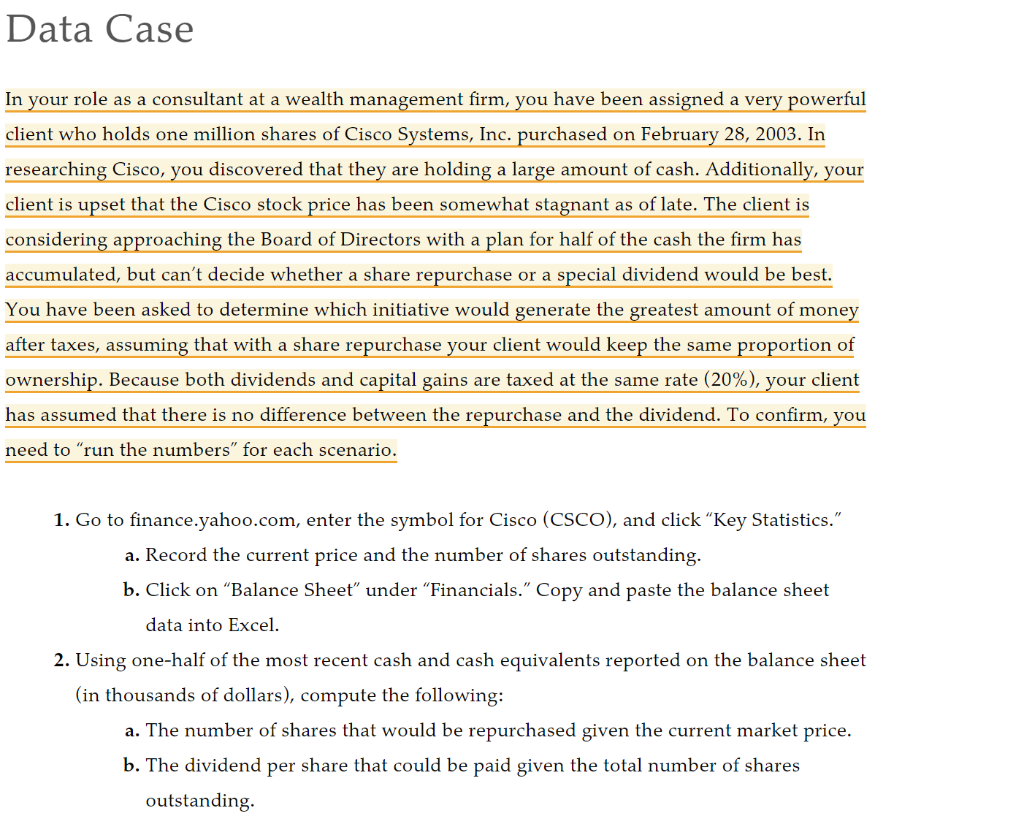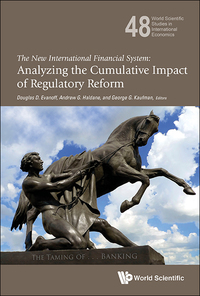 This is a continuation of my last post
This is a continuation of my last post

Data Case In your role as a consultant at a wealth management firm, you have been assigned a very powerful client who holds one million shares of Cisco Systems, Inc. purchased on February 28, 2003. In researching Cisco, you discovered that they are holding a large amount of cash. Additionally, your client is upset that the Cisco stock price has been somewhat stagnant as of late. The client is considering approaching the Board of Directors with a plan for half of the cash the firm has accumulated, but can't decide whether a share repurchase or a special dividend would be best. You have been asked to determine which initiative would generate the greatest amount of money after taxes, assuming that with a share repurchase your client would keep the same proportion of ownership. Because both dividends and capital gains are taxed at the same rate (20%), your client has assumed that there is no difference between the repurchase and the dividend. To confirm, you need to "run the numbers" for each scenario. 1. Go to finance.yahoo.com, enter the symbol for Cisco (CSCO), and click Key Statistics." a. Record the current price and the number of shares outstanding. b. Click on Balance Sheet" under Financials. Copy and paste the balance sheet data into Excel. 2. Using one-half of the most recent cash and cash equivalents reported on the balance sheet (in thousands of dollars), compute the following: a. The number of shares that would be repurchased given the current market price. b. The dividend per share that could be paid given the total number of shares outstanding. 3. Go to finance.yahoo.com to obtain the price at which your client purchased the stock on February 28, 2003. a. Enter the symbol for Cisco and click Get Quotes." b. Click Historical Prices, enter the date your client purchased the stock as the start date and the end date, and hit Enter. Record the adjusted closing price. 4. Compute the total cash that would be received by your client under the repurchase and the dividend both before taxes and after taxes. 5. The calculation in Step 4 reflects your client's immediate cash flow and tax liability, but it does not consider the final payoff for the client after any shares not sold in a repurchase are liquidated. To incorporate this feature, you first decide to see what happens if the client sells all remaining shares of stock immediately after the dividend or the repurchase. Assume that the stock price will fall by the amount of the dividend if a dividend is paid. What are the client's total after-tax cash flows (considering both the payout and the capital gain) under the repurchase of the dividend in this case? 6. Under which program would your client be better off before taxes? Which program is better after taxes, assuming the remaining shares are sold immediately after the dividend is paid? Data Case In your role as a consultant at a wealth management firm, you have been assigned a very powerful client who holds one million shares of Cisco Systems, Inc. purchased on February 28, 2003. In researching Cisco, you discovered that they are holding a large amount of cash. Additionally, your client is upset that the Cisco stock price has been somewhat stagnant as of late. The client is considering approaching the Board of Directors with a plan for half of the cash the firm has accumulated, but can't decide whether a share repurchase or a special dividend would be best. You have been asked to determine which initiative would generate the greatest amount of money after taxes, assuming that with a share repurchase your client would keep the same proportion of ownership. Because both dividends and capital gains are taxed at the same rate (20%), your client has assumed that there is no difference between the repurchase and the dividend. To confirm, you need to "run the numbers" for each scenario. 1. Go to finance.yahoo.com, enter the symbol for Cisco (CSCO), and click Key Statistics." a. Record the current price and the number of shares outstanding. b. Click on Balance Sheet" under Financials. Copy and paste the balance sheet data into Excel. 2. Using one-half of the most recent cash and cash equivalents reported on the balance sheet (in thousands of dollars), compute the following: a. The number of shares that would be repurchased given the current market price. b. The dividend per share that could be paid given the total number of shares outstanding. 3. Go to finance.yahoo.com to obtain the price at which your client purchased the stock on February 28, 2003. a. Enter the symbol for Cisco and click Get Quotes." b. Click Historical Prices, enter the date your client purchased the stock as the start date and the end date, and hit Enter. Record the adjusted closing price. 4. Compute the total cash that would be received by your client under the repurchase and the dividend both before taxes and after taxes. 5. The calculation in Step 4 reflects your client's immediate cash flow and tax liability, but it does not consider the final payoff for the client after any shares not sold in a repurchase are liquidated. To incorporate this feature, you first decide to see what happens if the client sells all remaining shares of stock immediately after the dividend or the repurchase. Assume that the stock price will fall by the amount of the dividend if a dividend is paid. What are the client's total after-tax cash flows (considering both the payout and the capital gain) under the repurchase of the dividend in this case? 6. Under which program would your client be better off before taxes? Which program is better after taxes, assuming the remaining shares are sold immediately after the dividend is paid
 This is a continuation of my last post
This is a continuation of my last post






